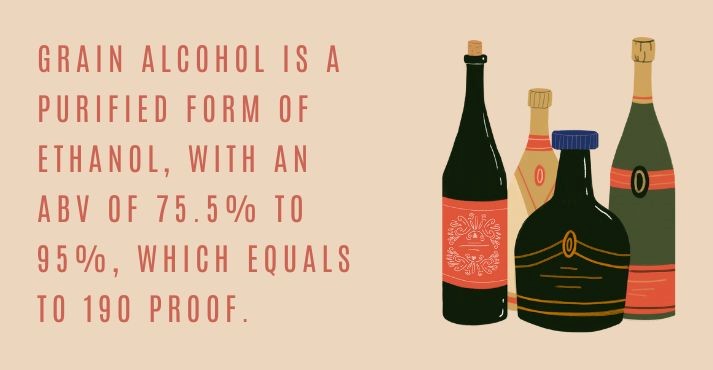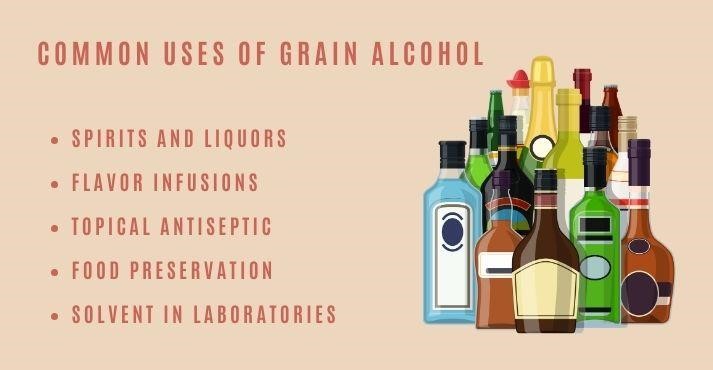For ages, grain alcohol has been the beverage of choice for people from all over the world.
As we examine the beer industry trends, the revenue in the beer market amounts to US$322.3bn in 2023. The market is expected to grow annually by 3.67% (CAGR 2023-2028).
Historically, grain alcohol has been part of various cultures, with its production dating back centuries. Grain alcohol has been central to developing many traditional and iconic alcoholic beverages across different civilizations.
It has been a critical element in traditional medicinal practices and is essential in preserving herbs and botanicals.
But do you know what grain alcohol is?
Grain alcohol, also known as ethanol or ethyl alcohol, is derived from the fermentation of grains, typically corn, wheat, or barley.
It is a colorless and flammable liquid, serving as the primary ingredient in spirits such as vodka, whiskey, and gin. Alcohol from wheat also has applications as a solvent in pharmaceuticals, cosmetics, and industrial processes.
In this blog, we will explore everything you need to know about the grain alcohol.
What is Grain Alcohol?

A pure grain alcohol is a highly purified product with a very neutral odor and taste. In its pure form, grain alcohol contains a minimum of 95 percent ABV.
Grain alcohol that is 200-proof (100 percent ABV) is not for human consumption. It can be made from corn, rye, wheat, grapes, grains, sugarcane, tubers, and beets.
Grain alcohol is harsh in its undiluted form, so you don’t consume it straight. Grain alcohol can be used for food and wine pairing and easily mixed with other grain alcohol drinks. Alcohol manufacturers often use it for making other alcoholic drinks like wine, vodka, homemade liqueurs, or cheap whiskey.
How is Grain Alcohol Made?

Grain alcohol is a clear liquid without color, smell, or taste. It has a very harsh, burning aftertaste that makes most people cough.
The production process of grain alcohol includes the following steps:
- Fermentation: Convert sugars into alcohol and carbon dioxide using yeast, creating a liquid mash.
- Distillation: Heat, vaporize, and condense alcohol to separate it from impurities in the mash.
- Rectification: Further purify alcohol through multiple distillation stages for increased purity and refinement.
- Dehydration: Remove water from the alcohol through various methods, concentrating the ethanol content.
- Filtration: Remove remaining impurities or particles from the alcohol to enhance clarity and purity.
- Blending: Mix different batches or types of alcohol to achieve the desired flavor, aroma, and characteristics.
- Bottling: Package the finished grain alcohol into bottles for distribution and consumption.
The value of cereal grains for alcohol production depends upon their high starch content. The conversion efficiency of starch will be around 96% if proper meshing and cooking have been done.
The most common types of grain alcohol used for making grain alcohol include corn, wheat, barley, rye, oats, sorghum, rice, millet, quinoa, and buckwheat.
Common Uses of Grain Alcohol

While grain alcohol is often consumed for its intoxicating effects, it should be consumed with caution due to its high alcohol content. Grain alcohol is distilled, purified, and reduced to the desired strength. As food science evolves, new applications are introduced for grain alcohols.
The most common grain alcohol uses are:
1. Spirits and Liquors
Grain alcohol is a crucial ingredient in producing spirits and liquors, serving as the base for many alcoholic beverages due to its neutral flavor.
2. Flavor Infusions
It extracts and carries flavors in infusions, enhancing and imbuing beverages or culinary creations with various tastes and aromas.
3. Topical Antiseptic
As an antiseptic, grain alcohol is applied topically to disinfect wounds and surfaces, owing to its ability to kill bacteria and other microorganisms.
4. Food Preservation
Grain alcohol can preserve fruits and herbs, preventing spoilage by inhibiting microbial growth and maintaining the quality of certain food items.
5. Solvent in Laboratories
In laboratories, grain alcohol is a versatile solvent for extracting, dissolving, and diluting various substances, contributing to chromatography and chemical analyses.
Famous Examples of Grain Alcohol
Here are some grain alcohol examples that food manufacturers commonly use.
1. Everclear
Odorless, flavorless, and colorless, Everclear grain alcohol is the premier high-proof grain alcohol for your liquid creations.
Everclear is a brand name for rectified spirits (grain alcohol and neutral spirits) produced by the American company Luxco (formerly the David Sherman Corporation). It is made from grain and is bottled at 60%, 75.5%, 94.5%, and 95% alcohol by volume (120, 151, 189, and 190 U.S. proof, respectively).
2. Alcohol-95
Alcohol-95 is a grain alcohol product characterized by its high ethanol content, typically 95%. Known for its purity, it serves as a base for various spirits and liquors.
Its neutral taste allows for versatile use in cocktails and flavor infusions. Commonly used in laboratories and industrial applications, it is not intended for direct consumption but is a crucial ingredient in many manufacturing processes.
3. Golden Grain
Golden Grain is made from 100% neutral spirits distilled from grain. This is an excellent spirit for punches or to make homemade liqueurs and extracts. Its neutral profile makes it perfect for extracting and infusing flavors.
Golden Grain is a brand of grain alcohol known for its use in crafting spirits. Distilled from grains like wheat or corn, it offers an ideal profile for producing a wide range of alcoholic beverages.
Golden Grain is a staple in the distillation industry and ensures quality and consistency, contributing to consumers’ diverse spirits.
4. Clear Spring
Clear Spring is a famous brand of grain alcohol recognized for its purity and clarity. Distilled from grains such as corn or wheat, it provides a blank canvas for flavor infusions and cocktail creations.
Widely used in commercial and home settings, Clear Spring is favored for its versatility, making it a key component in producing various spirits and liqueurs. Because of its high alcohol content, Clear Spring 190 Proof Grain Alcohol is very flammable and should be handled carefully.
Potential Side Effects of Grain Alcohol
As we explore the uses of grain alcohol, let’s dive into the potential side effects of grain alcohol.
Consuming grain alcohol, like any alcoholic beverage, can lead to various side effects, especially when consumed in excessive amounts.
- Impaired coordination: Excessive consumption can impair motor skills and coordination, increasing the risk of accidents and injuries.
- Nausea and vomiting: Grain alcohol irritates the stomach lining, leading to nausea and, in some cases, vomiting.
- Dehydration: Grain alcohol is a diuretic, increasing urine production and contributing to dehydration.
- Hangover: Overindulgence may result in a hangover characterized by headaches, fatigue, and nausea the morning after drinking.
- Cognitive impairment: Alcohol affects cognitive function, leading to confusion, poor judgment, and slowed reaction times.
- Risk of addiction: Regular and excessive alcohol consumption can lead to alcohol dependence and addiction.
- Liver damage: Chronic heavy drinking can cause liver inflammation, fatty liver, and more severe conditions like cirrhosis.
- Cardiovascular issues: Excessive alcohol intake can contribute to high blood pressure and increase the risk of cardiovascular problems.
- Weakened immune system: Prolonged alcohol abuse may weaken the immune system, making the body more susceptible to infections.
- Mood changes: Alcohol can impact neurotransmitters, leading to mood swings, anxiety, or depression.
- Sleep disturbances: While alcohol may initially induce drowsiness, it disrupts standard sleep patterns, leading to poor-quality sleep.
- Increased risk of accidents: Impaired judgment and coordination can increase the likelihood of accidents, including falls and automobile collisions.
Grain Alcohol (FAQs)
Is grain alcohol safe to drink?
Yes, it is safe to drink grain alcohol in moderation; grain alcohol intended for human consumption, such as those found in spirits and liquors, is generally safe for adults.
However, excessive consumption poses serious health risks, including alcohol poisoning, addiction, and long-term organ damage. Responsible and moderate consumption is advised.
Is vodka a grain alcohol?
Yes, vodka is typically made from grain alcohol. The primary ingredient in vodka is often distilled from grains like wheat, rye, or corn. Other sources, such as potatoes, grapes, or fruits, can be used, but grains are common in traditional vodka production.
Conclusion
Grain alcohol, a versatile ethanol-based product, finds diverse applications across industries. Grain alcohol has a neutral base, allowing for a broad spectrum of flavors.
Grain alcohol ingredients showcase their significance in industrial and laboratory settings, prized for their purity. The grain alcohol is also used in infused, contributing to creative blends. Despite its utility, responsible consumption is crucial to mitigate potential health risks.
Understanding its various applications in the food and beverage industry, emphasizing the need for informed and mindful use in recreational and industrial contexts. Now that you know what grain alcohol is, you must be mindful of its use in recreational and industrial contexts.












